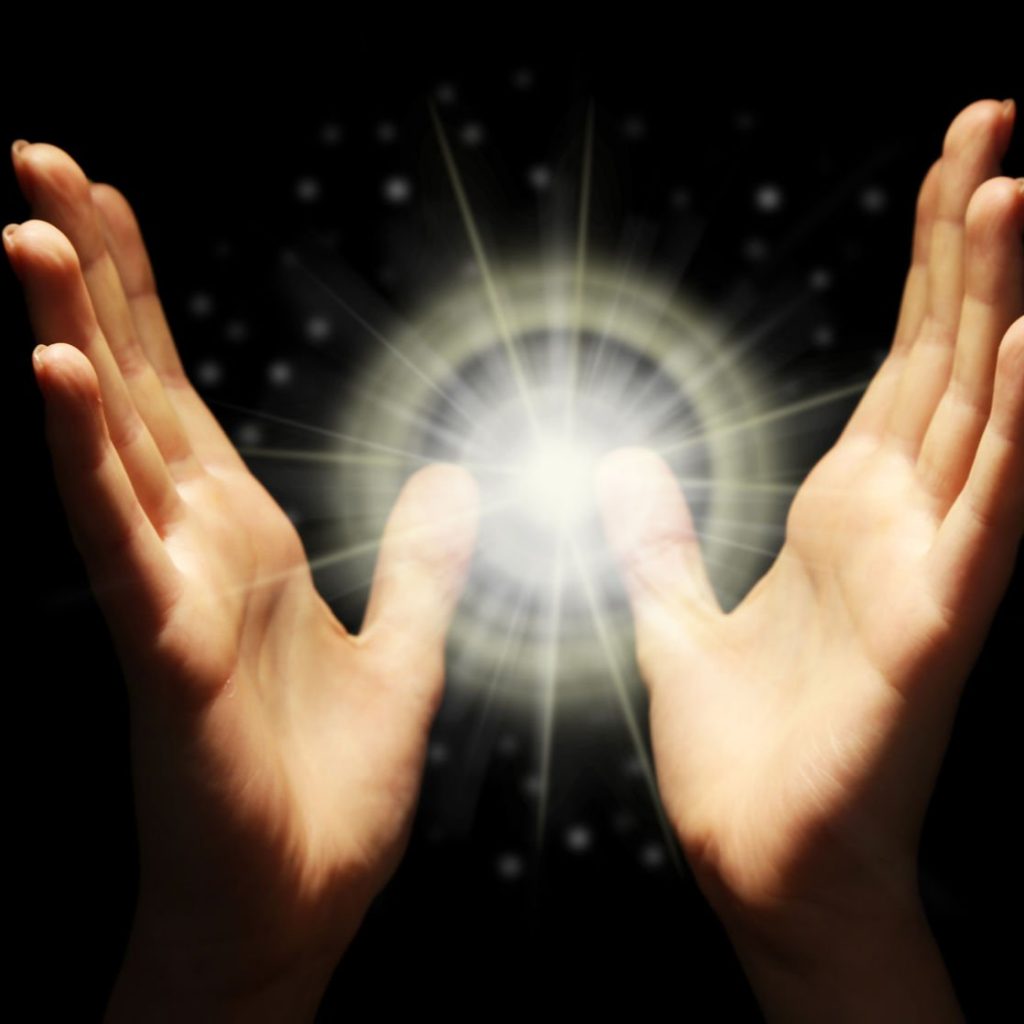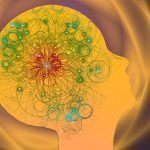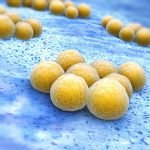Virender Sodhi, MD (Ayurved), ND
Ayurveda is one of the most ancient systems of medicine known today. The origins of this science of life (Ayu – life, and Veda – knowledge) have been placed by scholars of ancient Indian Ayurvedic literature at somewhere around 6000 BC.1
Ayurveda is the science of balance and health. Disease is seen as an imbalance, and its treatment involves diverse strategies to restore optimal function and balance. Using nutrition, yoga, exercise, meditation, complex integrated herbal formulas, and surgical techniques, the Ayurvedic physician treats the whole person – removing disease by ending the imbalance that created it.
History
Ayurvedic teachings were orally transmitted for thousands of years before being written down in melodious Sanskrit poetry. Forming a large part of the Vedas, the sacred texts upon which Hinduism is based, the healing art of Ayurveda is an integral part of Indian history and culture.
Around the 9th century BC, Ayurveda developed into 2 distinct schools. The school of surgeons, which was writing texts about injections, pre- and post-operative care, suturing, sterilization and hospitals. Their surgical techniques included treatment of cataracts, hemorrhoids, hernias, bone problems, renal and gallstones, and cosmetic corrections. Sushruta is considered the father of cosmetic and plastic surgery. I recently met the family whose forefathers used to be plastic surgeons and had developed their own instruments. They got the family name of Kanghare, from ‘kan’ meaning ear, and ‘ghare’ which means repair. The second school, the school of physicians, developed expertise in the nonsurgical medical wisdom of Ayurveda, including the Tridosh physiology, which classifies individuals into 3 mind-body types (vata, pitta, and kapha) and is the basis of modern Ayurveda.
Today Ayurveda addresses the growing number of individuals who want to understand and attend to the source of illness and take an active role in their own health promotion.
Philosophy
Ayurvedic philosophy is based on the Samkhya philosophy of creation. The word Samkhya is derived from the Sanskrit Sat (truth) and Khya (to know). It has influenced major strains of philosophy in both the East and the West. The basic tenets of this philosophy are as follows:
- There exists a close relationship between the individual and the universe. The individual is a microcosm, a universe within him or herself, while the external environment is the macrocosm.
- Cosmic energy is manifest in all living and non-living things.
- The source of all existence is cosmic consciousness, manifest as male (Shiva, Purusha) and female (Shakti, Prakriti) energy.
Purusha, the male principle, is formless, colorless, beyond attribute, and denoted by GOD SHIVA. It is quiescent, does not take an active part in the manifestation of the universe, and has passive awareness. Prakriti, the female principle, gives form, color, awareness, and choice, and is denoted by GODDESS SHAKTI. It is the interaction of these male and female forces that infuses each living and non-living entity with its unique form and expression.
Five Basic Elements and the Universe
(Panchbhuta Philosophy)
The great seers realized the Samkhya philosophy perceived that consciousness consists of 5 basic elements or principles. Ayurvedic knowledge is based on the concept that these basic elements, ether (space), air, fire, water and earth, not only make up the world around us, but our human form as well as the microcosm.
At the beginning of the world, consciousness was without form, existing as the subtle cosmic vibration of Aum. Within these vibrations appeared the element Ether. Ether started to move, creating Air. The movement of Ether also produced friction and, through friction, generated heat, then Fire. From the heat of the Fire, ethereal elements dissolved and liquefied into Water, then solidified to form molecules of Earth. Thus all matter was born of the 5 elements. These 5 elements exist in subatomic forms.
Individuals are a microcosm of nature and, as such, are themselves comprised of the 5 basic elements.
Ether is represented in the hollow spaces of the mouth, nose, gastrointestinal tract, abdomen, thorax, respiratory apparatus, capillaries, lymphatics, tissues and cells.
Air exists as movement – as pulsation, expansion, or contraction of the various organs. Bodily movement is controlled by the central nervous system, itself governed by Air.
Fire, the source of heat and light, is somatically represented as metabolism, gray matter, vision, temperature, digestion and intelligence.
Water exists as secretions of the salivary and digestive glands, the mucous membranes, and within plasma and cytoplasm.
Earth is the solid structure of the bones, cartilage, nails, muscles, tendons, skin and hair.
The 5 elements also connect with the 5 senses (table 1). For example, air is related to skin and the sense of touch. Its organ of action is the hand, which is especially sensitive. It is also the organ of holding, giving and receiving.
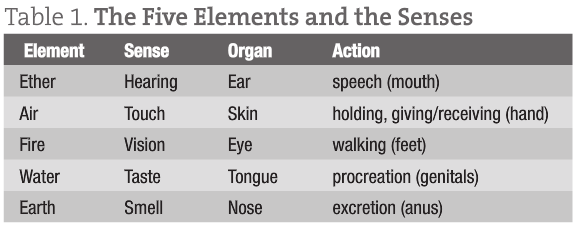
Our 5 elements are constantly in touch with the universe through our 5 highly sensitive sensors (senses) and constantly receiving and transmitting information.
The Origins of Body Types
One of the greatest human instincts, one of our deepest desires, is to create new generations. This is true of all creatures on earth. In nature, most animals mate only during certain seasons. Ayurveda believes that these patterns are also part of human nature, but that our natural reproductive instincts have been distorted with time because of accumulated stress. Ancient Ayurvedic text states sex is a means to pass on our DNA rather than something to be used only for pleasure. However, sexual activity has come to be associated primarily with pleasure. Today for many people, procreation is a side effect and an often undesirable one at that. Every form of media available to us, movies, television shows, books and advertisements openly discuss or display sexual activity for the sole purpose of pleasure. Moreover, there has been a loss of focus on family unity, resulting in high divorce rates, alcoholism and drug abuse. Yet, the current popularity of the terms “tradition” and “family values” indicates that we may be beginning to reconnect with our most basic instincts. We may be beginning to listen to that most ancient yearning voice speaking to us on all levels – mental, emotional, spiritual and physical.
Humans have been carrying virtually the same DNA information for millions of years, passing it on from generation to generation. We each have a built-in sense of responsibility to pass this valuable information on to our children intact. But tragically, our widespread use of chemicals such as pesticides, insecticides, and other manmade chemicals are changing our DNA patterns and unraveling the very fabric of humanity. These environmental pollutants are having an, as yet, immeasurable effect on humanity. They are altering us on deep mental, emotional and physical levels. We are affecting future generations in unseen and unforeseeable ways. We are irresponsibly fooling around with the future of all life on this planet and creating a generation of people and other creatures who are sick. Of course no parent wants their child to be ill. We all want the best for them and must really look at what we are putting into our bodies, into our water, and into our air.
Ayurveda teaches that our body types are determined by our parents’ constitutions, the relationship between our parents before and during pregnancy, the time of day and year we were born, and the placement of the planets during our birth. If either parent or their relationship to one another is unhappy or unhealthy in mind, body or spirit, we may be born with an imbalanced constitution.
Very few of us realize that when we have sexual relations, our cells are shared and combined with the other person’s resulting in profound and lasting effects to our whole being. Unlike the popular myth of the one-night stand, it is not really possible to meet someone, have sex, and be done with it. Instead, every sexual union creates lasting effects in both people. Also, if a child should result from the union, then that child not only receives these genes, but is also deeply affected by the mental, emotional and physical states of the parents during the time of conception. This is why Ayurved views mating as something that requires careful consideration and long-term commitment.
The creation of a child begins as early as the moment the parents first meet. In order for a truly healthy child to be born, there needs to be a lot of love and affection between the parents in the beginning, as well as throughout their relationship. Even prior to conception, this love or lack of it will affect the child in a profound way. The child will, however, be most strongly affected by the parental relationship at the time of conception, as these thoughts and emotions will be directly transferred to the child.
The atmosphere between parents is one of the primary factors that affects one’s unique body type. However, a person’s constitution is also determined by the individual body types of both their mother and father. For example, if someone’s parents, grandparents and great-grandparents were all under 5 ft-5 in tall, that person isn’t likely to grow to a height of 6 ft-10 in. It is simply not in their genetic makeup.
One’s physical, emotional, mental and spiritual characteristics (eg, body type), is partly a result of their parents’ genetic traits. However, the relationship between parents and their actions and thoughts toward a person while they were a fetus also determines their constitution. This is a fact recognized by many cultures. In India, for example, it is believed that telling a fetus tales of spiritual individuals will instill their particular spiritual qualities in the fetus. My mother tells me that while I was in her womb, she would read me stories of the Buddha. She insists that I have characteristics similar to those of Buddha and that my actions reflect his teachings. If this seems surprising, just think of the scientific studies showing that a mother’s unhealthy habits, such as smoking and drug and alcohol abuse have direct adverse effects on her fetus. This is a known and accepted phenomenon but what isn’t so widely accepted is that the mother’s nutritious diet and positive mental, emotional and spiritual states during pregnancy also have good and lasting effects on her child.
As mentioned earlier, parents’, especially one’s mother’s actions, thoughts and feelings; parents’ genetic makeup and their relationship to one another; as well as the time of day, month and year that a person was born all work together to determine their body type. These factors also influence whether or not their constitution was in a balanced state when they were born.
Determining Body Type
Determining your body type allows you to learn how to create balance in your mind, body and spirit, thereby allowing you to achieve and maintain optimal health. Moreover, when you are functioning at optimal levels, you benefit not only yourself, but also the world around you. You affect the people and places around you in a positive way. Everything that you are a part of becomes healthier; all of our relationships become healthier; your family becomes healthier; even your community becomes healthier. Indeed, your well-being has a great effect on everything and everyone you touch, not just your friends, family and community, but even your state, nation, continent and world, and even the universe, on all levels. This is because you are an inseparable part of all things.
In individuals, the 5 elements manifest as the tridosha. Dosha means protective, or when out of balance, disease-producing. The tridosha are the 3 humors, or metabolic forces, which make up the mind and body. They are vata, pitta and kapha.
Vata = Ether + Air
Pitta = Fire + Water
Kapha = Water + Earth
At the time of fertilization, permutations of vata, pitta and kapha determine the constitution of the new individual. These 3 metabolic forces control all biological, psychological and physiopathological functions of the body, mind and consciousness and have subtle properties, as shown in table 2. They determine personality traits and physiological structure. These basic traits will also be shaped by gender and other important factors such as diet, lifestyle, behavior, emotions, and seasons.
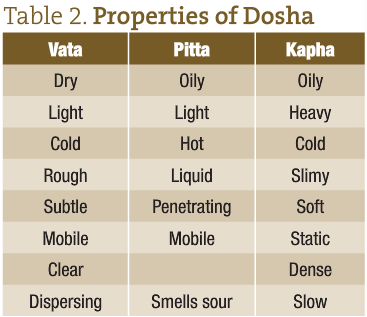 The unique individual constitution produces natural urges and individual tastes in food, flavor and temperature. They govern the maintenance and destruction of bodily tissue and the elimination of waste products. They are also responsible for psychological phenomena, including emotions of fear, anger and greed, as well as the highest order of emotions: understanding, compassion, and love.
The unique individual constitution produces natural urges and individual tastes in food, flavor and temperature. They govern the maintenance and destruction of bodily tissue and the elimination of waste products. They are also responsible for psychological phenomena, including emotions of fear, anger and greed, as well as the highest order of emotions: understanding, compassion, and love.
Functions of the Tridosha
A balance of the dosha is necessary for optimal health. The doshas increase by similar properties and are diminished by the opposite ones. For example, vata is dry, light and cold so any food, medicine, lifestyle or behavior that increases these qualities will increase vata within the body. Conversely, oily, heavy or hot factors will decrease vata. Together, they govern all metabolic activities; anabolism (kapha), catabolism (vata), and metabolism (pitta).
There can be up to 7 different constitutions depending upon the permutation and combination of vata, pitta and kapha (table 3). The combination of the 3 humors remains unchanged throughout an individual’s lifetime and can indicate a person’s inherent strengths and susceptibilities. The combination can, however, respond to environmental changes such as diet and lifestyle, thereby providing the opportunity for the individual to maintain health or compromise it.
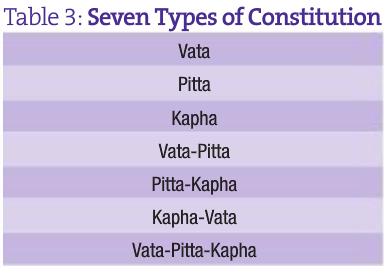 Life is considered a sacred path in Ayurveda; a ceaseless interaction between the internal (tridosha) environment and the external environment, or the sum of cosmic forces. To counterbalance external change, an individual may create a balance in the internal forces by altering thought, diet, lifestyle, and behavior.
Life is considered a sacred path in Ayurveda; a ceaseless interaction between the internal (tridosha) environment and the external environment, or the sum of cosmic forces. To counterbalance external change, an individual may create a balance in the internal forces by altering thought, diet, lifestyle, and behavior.
The characteristics of the corresponding psychosomatic constitutions are listed in table 4.
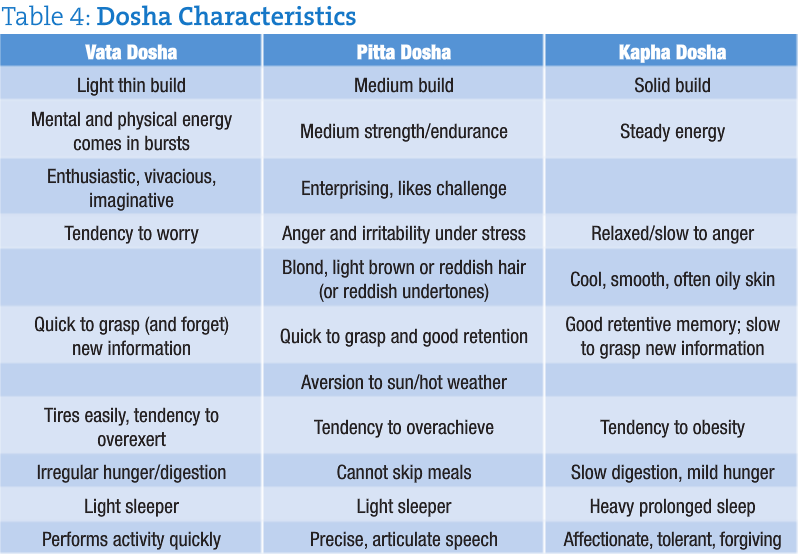
The distinct physical characteristics of each body type add to the variety and color of human life. No one quality or dosha is more desirable than another because each has important beneficial contributions to make to humanity as a whole. Our emotions are as integral to our being as are our physical bodies and the doshas influence our emotions just as they influence our physical characteristics and activities.
Characteristics of Vata
Physically, vata-type people generally have a thin, light frame and have a hard time gaining weight. Their faces and shoulders tend to be narrow. In addition, they are often either very tall or very short with limbs out of proportion to the rest of their body. Such a person may stand over 6 ft tall and have very long arms, legs, fingers and toes, and a short torso. Vatas have a tendency toward thin, coarse, dry hair and skin. Also, because of loss of lubrication as a result of dehydration, vata people are prone to problems with arthritis and weak joints that frequently make cracking sounds.
Because of vata’s inherent dryness, their stool is usually harder than those of either pita or kapha. This dryness and lack of oiliness can lead to problems of constipation. Also, vata’s other excretions, menstruation, urination, mucus and sweating, are scanty compared to those of other doshas. Vata menses are often painful. They get cramps easily and, when out of balance, have a tendency toward PMS and dysmenorrhea.
Aside from constipation caused by dehydration, vatas tend toward diarrhea and other digestive difficulties when vata is out of balance. Indeed, digestive disturbances are common to all of us when our vata dosha is out of balance. It’s the primary reason that digestive aids are fixtures in medicine cabinets throughout the United States.
Vatas have the lowest physical endurance of all the constitutions. They have bursts of energy followed by exhaustion. It is easy for vata to exhaust their adrenal glands, often leaving them with low function. Vata people can’t tolerate strong doses of medicine and need to be careful with drugs in any form, including aspirin and alcohol. They also have a rapid and strong reaction to stimulants such as coffee, chocolate and sugar. The danger is they may become addicted to the very stimulants that provide them with temporary bursts of energy, yet exhaust their bodies more deeply and thoroughly over long-term use.
Vata sexual energy is on the low side. A vata person can be easily excited and tired and becomes quickly disinterested in sexual activity once aroused. However, vatas love to be hugged, kissed and cuddled. Through this outward affection, they convey their inner thoughts and emotions. They communicate most directly through touch and have a natural desire for physical affection and warm, sweet things in general. They gravitate toward warmhearted people, warm climates, and warm cooked foods.
They also have a variable appetite for all things, which often proves frustrating for those around them. Mothers of vata-type children are likely to become exasperated by this trait, wondering why their child eats well one day and will hardly touch their favorite meal the next.
Vatas grasp new ideas and information quickly but are also quick to forget. These people often worry.
In our modern society we tend to think that characteristics such as a predisposition to constipation or worry are bad. However, all of the above qualities are beneficial if kept in proper balance. If a family is heading out to catch an airline flight, it is the vata who will get them there on time and remember the tickets.
Vatas walk fast, talk fast and think quickly. They have a sensitivity toward stress, particularly noise, and have difficulty in following a routine or discipline making it triply hard for them to stay in balance.
They are usually light sleepers and the smallest sound can easily disturb their rest. Even a cricket might wake a vata, while a kapha can happily snore beside a band playing loudly. When out of balance, vatas often suffer from insomnia. They can have difficulty falling asleep, or can wake in the middle of the night and end up staring at the ceiling for hours worrying about yesterday’s unfinished chores, unable to go back to sleep.
Vata dosha, in particular, influences our emotions. Vatas have a tendency toward feelings of anxiety, fear and worry, and will dwell on small concerns until they become big ones. Just as they are easily awakened by small sounds during sleep, they can be easily startled or frightened by things that wouldn’t phase a pita or kapha.
Vata likes adventure and unknown outcomes. They change their minds and moods easily and have difficulty making decisions. When they finally do make a decision, they will often do so without weighing the consequences of that decision fully. This characteristic often results in poor money management.
Vatas love to talk, but can deplete their energy by talking too much. Speaking too many words, especially if these words lack meaning, can lead to wasted energy. An old saying from India and other countries and cultures advises us to speak conscientiously to avoid wasting words because each word holds importance and little energy is wasted. And, people are more likely to listen to what you have to say if you are not prone to babbling. Also, following this ancient multicultural wisdom leaves more energy available for our bodies to utilize in other beneficial and enjoyable activities.
Characteristics of Pita
Moderate is a key word for pita-types. Physically, they usually have a medium to large frame and a mesomorphic body type. They have mild strength and endurance and, while usually the initiators of sexual activity, have only a moderate sexual capacity. Pitas however, do not have moderate appetites. They are almost always hungry, yet their strong metabolism usually allows them to eat a substantial amount of food and still not gain weight. Kaphas, who gain weight easily, are frequently jealous of pitas. They are known to say things like “My wife can eat anything she pleases, but if I even look at an ice cream cone I gain ten pounds.” Pita people are also almost always thirsty and should drink a lot of water.
If you burn or freckle easily, your prakriti is probably dominated by pita dosha. Pita type people often have light-colored skin and hair with a tendency toward baldness at an early age. The pita dosha is hot, therefore they do not like the heat and will always seek shade on a sunny day. Similarly, they have a tendency toward heartburn, ulcers, hemorrhoids and inflammatory diseases.
Pita-dominated bodies collect toxins quickly, making it difficult to tolerate air and water pollution or to handle substances such as alcohol, coffee and nicotine. This can cause diseases in the organs of elimination, particularly the skin, kidneys and liver. In fact, alcohol consumption is one of pita’s worst enemies, leading to a host of liver problems. Moreover, people with a dominant pita dosha bleed easily, so anti-inflammatory drugs such as aspirin and ibuprofen often cause internal hemorrhaging. Thus, pitas should avoid anti-inflammatory drugs. Regarding drugs, the doses they need are usually mid-range.
Pitas have a sharp intellect, wit and good retentive memory. However, they are also sharp in other ways. They often speak harshly and can easily become angry, irritable or impatient and just as quickly, let it go. They are able to let small concerns evaporate.
Emotionally, pitas are go-getters, overachievers and workaholics. They are perfectionists, driven to succeed. I like to joke that pita people make exceptional employees, always giving 200%, but make terrible bosses, demanding perfection both of themselves and their employees. Pita bosses will work their employees into the ground.
Although pita people can make enemies easily as a result of their sharp speech, they make wonderful public speakers. They are fighters, loudly and boldly voicing their beliefs and opinions. If you were to survey a group of people demonstrating against nuclear power plants, you would probably discover that the most vocal participants are pita.
Pitas have a hard time settling down in the evenings, however once they do go to bed, they usually sleep well, from 6 to 8 consecutive hours.
Pitas are more visually oriented than people of other constitutions. They adore beautiful clothing, jewelry and landscapes, love to visit museums and surround themselves with visual beauty of all kinds. A pita person’s home will often reflect this tendency, with beautiful paintings hanging on the walls and fresh flowers in a vase on the table. Another aspect of pita’s visual orientation is that they must see things before they will believe them, requiring tangible evidence as proof. If you tell a pita person 2 + 2 = 4, they will not believe you until you visually demonstrate that this is so. Also, they are rarely satisfied with a project until they see measurable results.
Characteristics of Kapha
Kapha-type people are generally large and strong, both physically and emotionally. Their bones are huge and heavy and their muscles strong. Kapha eyes are unusually big and beautiful, like doe eyes. This type is smell oriented. Kaphas have powerful immune systems, making them more resistant than either vata or pita when the latest cold or virus is making the rounds. They can also process drugs more easily than either vata or pita, usually requiring the full dosage of a particular medicine, In general, kapha people have tons of stamina and can perform heavy physical labor more easily than the other body types. In fact, they need to exercise more heavily than other people in order to keep their weight in check. They do like to sleep however, and there’s a joke that kaphas will never want to wake up.
Kapha people easily gain weight. This tendency is amplified by their love of sweets and milk products, which aggravate kapha’s tendency to get bogged down with mucus. In spite of their unusually strong immune systems, when out of balance, they frequently suffer from mucus diseases such as colds and allergies.
Because kapha dosha is inherently cold and damp, people dominated by this dosha often dislike cold, wet weather and cold foods. However, because of their overall strength and solidity, they are tolerant of cold.
Kapha people are slow to grasp new ideas, but again, just like the elephant, once they learn something, they will remember it forever. They take a long time to make decisions, carefully weighing the options. Kaphas speak slowly, precisely and intelligently. They move slowly. Like vata, they also tend to get into habits of false stimulation in order to alter their slow natures, drinking too much coffee or alcohol, for example.
Kaphas have a great sexual capacity and usually love to have lots of kids. They are emotionally solid and very nurturing, loving, affectionate people. It takes a lot to ruffle a kapha’s feathers. However, though easygoing and forgiving, they are only forgiving to a point. Like an elephant, they are very tolerant, but if pushed too far, they will become your worst enemy. If out of balance, kapha’s affection for people and things can become possessive and unreasonably attached to inanimate objects, houses, cars, etc. This tendency is connected to their dislike of change.
A popular illustration of the relationships of the different body types is this. A vata will go to a garage sale to buy a shirt where the history of the merchandise is dubious and the quality and price vary widely; a pita will go to Gucci, where prices are expensive and quality is assured; and a kapha will research the clothing market and buy with discrimination.
Summary
We are constantly interacting with our internal and external environment. Depending upon our body constitution, thought process, behavior, nutrition, exercise and stress adaptability, we will react differently and produce a different set of chemicals, creating a positive or negative impact on the body. According to Ayurvedic medicine, disease is pragya apradh. Pragya is intelligence, apradh means mistake – disease is a mistake of intelligence. The body’s inherit intelligence is doing millions of functions every second perfectly; whenever there is imbalance in this intelligence, we create a disease process. Balance is achieved by following the laws of Mother Nature, and balancing one’s body according to body type, season, and environment with nutrition, yoga, meditation, exercise and medicine.
 Virender Sodhi, ND, MD (Ayurveda) is an internationally respected Ayurvedic and naturopathic physician, and one of the first to practice Ayurvedic medicine in the U.S. He received his MD (Ayurveda) after completing six years of medical training in India. He came to the U.S. in 1986 to share Ayurveda as part of a cultural exchange program. In 1988, Dr. Sodhi graduated from Bastyr University. Dr. Sodhi treats patients from all over the world at the Ayurvedic and Naturopathic Medical Clinic in Bellevue, Wash. He also lectures extensively throughout the U.S. and other countries, and is the founder of Ayush Herbs, Inc. Visit www.ayurvedicscience.com and www.ayush.com.
Virender Sodhi, ND, MD (Ayurveda) is an internationally respected Ayurvedic and naturopathic physician, and one of the first to practice Ayurvedic medicine in the U.S. He received his MD (Ayurveda) after completing six years of medical training in India. He came to the U.S. in 1986 to share Ayurveda as part of a cultural exchange program. In 1988, Dr. Sodhi graduated from Bastyr University. Dr. Sodhi treats patients from all over the world at the Ayurvedic and Naturopathic Medical Clinic in Bellevue, Wash. He also lectures extensively throughout the U.S. and other countries, and is the founder of Ayush Herbs, Inc. Visit www.ayurvedicscience.com and www.ayush.com.
Reference
- Gordon BL. Medicine Throughout Antiquity. Philadelphia, PA: FA Davis Co.; 1949:313-354.

